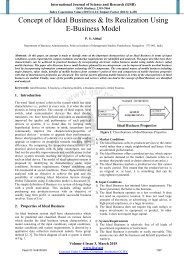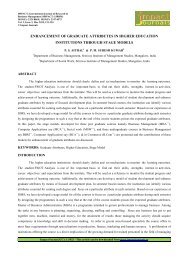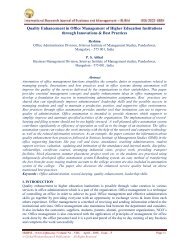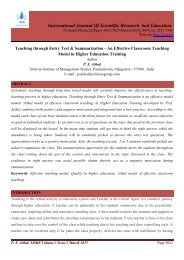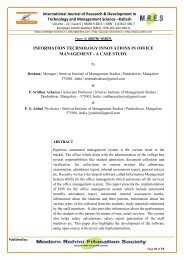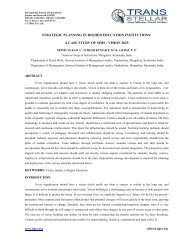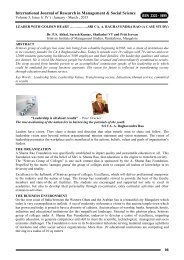How Innovations and Best Practices can Transform Higher Education Institutions : A case study of SIMS
Education has become competitive so as the educational institutions. In order to survive the competition, institutions have to improve the quality of their services. Changes in culture, aspiration and levels of skills required in securing employment for students, force higher education institutions today to rework on their educational models and add value to each and every aspect of their service. Innovations and best practices serve to enhance quality and add value. Srinivas Institute of Management Studies (SIMS), which combines technology, management and social service education has identified and implemented innovations and best practices to differentiate itself among the competitors and to add value in its educational services. In this paper, we have discussed innovations, small and big, develped indigineously and implemented during last four years. They are broadly classified under six key aspects namely "curricular aspects, teaching-learning and evaluation, research, consultancy and extension, infrastructure and learning resources, student support and progression, and governance, leadership, and management". The paper also contains some of the intitutional and individual faculty best practices having visible impact on the quality of higher education imparted by the institution. The best practices concern admission, fees, attendance, teaching, performance, skill building, employability, student involvement, collective learning, value addition, ensuring transparency, information dessimination etc. Finally two institutional best practices are elaborated with its aim of practice, underlying principles and concepts, particular contextual features or challenging issues that have had to be addressed in designing and implementing the practice, and its implementation, including its uniqueness in Indian higher education, evidence of success, identifying the problems encountered and resources required to implement the practice.
Education has become competitive so as the educational institutions. In order to survive the competition, institutions have to improve the quality of their services. Changes in culture, aspiration
and levels of skills required in securing employment for students, force higher education institutions
today to rework on their educational models and add value to each and every aspect of their service. Innovations and best practices serve to enhance quality and add value. Srinivas Institute of
Management Studies (SIMS), which combines technology, management and social service education
has identified and implemented innovations and best practices to differentiate itself among the competitors and to add value in its educational services. In this paper, we have discussed
innovations, small and big, develped indigineously and implemented during last four years. They are
broadly classified under six key aspects namely "curricular aspects, teaching-learning and evaluation, research, consultancy and extension, infrastructure and learning resources, student support and progression, and governance, leadership, and management". The paper also contains some of the
intitutional and individual faculty best practices having visible impact on the quality of higher education imparted by the institution. The best practices concern admission, fees, attendance, teaching, performance, skill building, employability, student involvement, collective learning, value
addition, ensuring transparency, information dessimination etc. Finally two institutional best practices are elaborated with its aim of practice, underlying principles and concepts, particular contextual features or challenging issues that have had to be addressed in designing and implementing the practice, and its implementation, including its uniqueness in Indian higher
education, evidence of success, identifying the problems encountered and resources required to implement the practice.
Create successful ePaper yourself
Turn your PDF publications into a flip-book with our unique Google optimized e-Paper software.
International Journal <strong>of</strong> Management (IJM), ISSN 0976 – 6502(Print), ISSN 0976 - 6510(Online),<br />
Volume 6, Issue 2, February (2015), pp. 83-98 © IAEME<br />
Secondly, many students are not aware <strong>of</strong> the merits <strong>and</strong> advantages these programs would <strong>of</strong>fer in<br />
terms <strong>of</strong> securing jobs <strong>and</strong> ensuring performance. As an institution which has pioneered such<br />
innovations, popular acceptance may take time. Many students find that the work load will be too<br />
much by volunteering for such courses. Apart from above, indentifying suitable courses which have<br />
futuristic dem<strong>and</strong> is also tough. Sparing the time <strong>and</strong> additional preparation <strong>of</strong> the faculty <strong>of</strong> the<br />
college acts as a burden.<br />
The resources required are the following:<br />
1. Manpower - Tapping expertise as well as upgrading the existing faculty for the conduct <strong>of</strong> the<br />
programmes.<br />
2. Cost - The entire certificate programmes are <strong>of</strong>fered free <strong>of</strong> cost. The institution bares all the<br />
expenses.<br />
3. Time - Additional working hours are fitted into the regular schedules through substitution <strong>of</strong><br />
filling.<br />
4. Infrastructure - The classrooms, library <strong>and</strong> laboratory are available with the institute.<br />
5. Transcript - The course plan as well as the pass certificate are provided under the seal <strong>of</strong> the<br />
college.<br />
VII.<br />
CONCLUSION<br />
The introduction <strong>of</strong> innovations <strong>and</strong> best practices in <strong>SIMS</strong> has resulted in changed<br />
philosophy <strong>and</strong> approaches to teaching-learning process. The managerial theory namely -Theory X<br />
<strong>and</strong> Theory Y propounded by McGregor [11] as applied to students in an educational institution has<br />
given way to new set <strong>of</strong> assumptions based on theory Y. The following are the modified assumptions<br />
based on theory X.<br />
• Most students are basically lazy <strong>and</strong> do not want to <strong>study</strong>. They are coming for studies because<br />
<strong>of</strong> their parents who force them.<br />
• They have no interest in attending classes <strong>and</strong> writing assignments.<br />
• Internal marks are serving as motivators.<br />
• They do not take examinations seriously.<br />
• High marks as a desire is cherished by most <strong>of</strong> the students, but they are not prepared to toil<br />
<strong>and</strong> get it.<br />
• They have taken the course only for the sake <strong>of</strong> getting a job.<br />
• Examinations are treated as botheration <strong>and</strong> unnecessary burden. They want to pass the course<br />
merely spending specified years in the course without any evaluation.<br />
• If any job is <strong>of</strong>fered, they are ready to leave the course.<br />
The following are the assumptions based on theory Y.<br />
• All students are not basically lazy. Their interest in studies could be created by the teacher<br />
using improved methods <strong>of</strong> teaching <strong>and</strong> closely working with them.<br />
• With constant support <strong>and</strong> advise, they will attend all classes. Wrong temperament <strong>of</strong> the<br />
teachers, love for more leisure <strong>and</strong> wrong friends are influencing to keep away from the<br />
classes.<br />
• Internal marks are good motivators if utilized appropriately by the teachers. Unrealistic targets,<br />
harsh deadlines <strong>and</strong> wrong distribution <strong>of</strong> marks make them disillusioned.<br />
• Students take examinations seriously if evaluation is suiting to reward their capability. Wrong<br />
methods <strong>of</strong> evaluation <strong>and</strong> wrong practice <strong>of</strong> examinations make it meaningless.<br />
• Desire to get high marks have to be accompanied by preparedness to work more. The fault<br />
<strong>can</strong>not be attributed to students. It is a fault <strong>of</strong> the system.<br />
97




